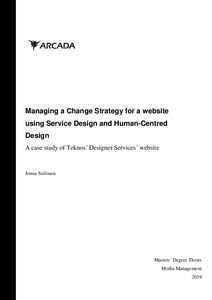Enhancing architectural processes through service design : integrating service design methods into architectural workflows: toward user-friendly built environments
Ahmed, Sabbir (2025)
Ahmed, Sabbir
2025
All rights reserved. This publication is copyrighted. You may download, display and print it for Your own personal use. Commercial use is prohibited.
Julkaisun pysyvä osoite on
https://urn.fi/URN:NBN:fi:amk-2025062023381
https://urn.fi/URN:NBN:fi:amk-2025062023381
Tiivistelmä
The thesis examines the potential of service design practices to help architects create more user-centered, sustainable and adoptable built environments. Conventional architectural design tends to focus more on the technical and aesthetic aspects rather than the experience of the people using the space, thus creating an environment that could serve the structural purpose but fail to satisfy the needs of the human being. In this study, to close this gap, the strategic combination of service design principles, including empathy, co-creation, iterative prototyping, etc., into architectural processes is proposed.
The study uses a mixed-methods design and relies on qualitative interviews with architects, service designers, and users, observational data, workshop results, and case studies of outstanding built work. Such tools as stakeholder mapping, journey mapping, creating personas were experimented with regarding their applicability and flexibility to be used in various stages of architectural design. These were put in the context of the Double Diamond design model to evaluate how they affect decision-making, user involvement, and design outcomes.
The results show that service design approaches improve the cooperation between stakeholders, help to understand the needs of the users better and enable flexibility in the design process. The conclusion of the research is that the implementation of the service design in the field of architecture not only helps to find better solutions in space, but reconsiders architecture as a service-based, collaborative field. The proposed thesis provides a pragmatic model to integrate user experience into the prescription of architects to create more inclusive, compassionate and future-resilient environments.
The study uses a mixed-methods design and relies on qualitative interviews with architects, service designers, and users, observational data, workshop results, and case studies of outstanding built work. Such tools as stakeholder mapping, journey mapping, creating personas were experimented with regarding their applicability and flexibility to be used in various stages of architectural design. These were put in the context of the Double Diamond design model to evaluate how they affect decision-making, user involvement, and design outcomes.
The results show that service design approaches improve the cooperation between stakeholders, help to understand the needs of the users better and enable flexibility in the design process. The conclusion of the research is that the implementation of the service design in the field of architecture not only helps to find better solutions in space, but reconsiders architecture as a service-based, collaborative field. The proposed thesis provides a pragmatic model to integrate user experience into the prescription of architects to create more inclusive, compassionate and future-resilient environments.
Kokoelmat
Samankaltainen aineisto
Näytetään aineisto, joilla on samankaltaisia nimekkeitä, tekijöitä tai asiasanoja.
-
Managing a Change Strategy for a website using Service Design and Human-Centred Design : A case study of Teknos´ Designer Services´ website
Seilonen, Jonna (2019)This study is based on the website service development. It analyses how a change strategy may be managed for a website based on user preferences and recommendations. The aim of the study is to provide recommendations as ... -
Personal experiences in the design process : how designers recognize and utilize their personal experiences in the design process
Tiensivu, Maaria (Turun ammattikorkeakoulu, 2016)The thesis explores how designers utilize and reflect on their personal experiences within the design process. It tackles the reasons why these experiences should not be automatically rejected as biased and why critical ... -
Design in Games : game design and how does design affect the perception of the game?
Poryadina, Daria (2022)Game design is a very important part of the game development process. Creation of game content, bringing it into technical compliance. The study of the features of game design and its impact on the perception of the player ...



